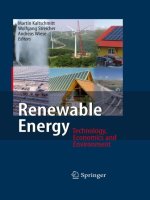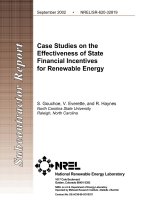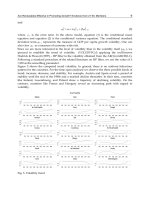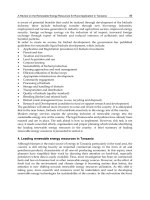Biomass for renewable energy, fuels and chemicals
Bạn đang xem bản rút gọn của tài liệu. Xem và tải ngay bản đầy đủ của tài liệu tại đây (31.27 MB, 649 trang )
ABOUT THE AUTHOR
Dr' Donald L. Klass is Director of Research for Entech International, Inc.,
an energy and environmental consulting firm headquartered in Barrington,
Illinois. He also serves as President of the Biomass Energy Research Association,
a membership association in Washington, D.C. founded in 1982 by industry
and university researchers throughout North America. He is a member of
several research advisory boards and business development committees, and
a consultant to industry and government, both U.S. and foreign. Formerly, Dr.
Klass managed biomass, natural gas, and petroleum research and educational
programs for the Institute of Gas Technology and the petroleum industry.
Over a 40-year period, his R&D and commercialization experience has been
concentrated on the conversion of virgin and waste biomass to gaseous and
liquid fuels and chemicals, the development of petrochemical, refinery, and
gas separation processes, the microbial production of substitute natural gas
from biomass and single cell protein from methane and methanol, and the
development of electroviscous fluids. Dr. Klass is the author or co-author of
over 300 papers and patents in these fields and the editor of 27 books on
energy and fuels. He received his B.S. in chemistry from the University of
Illinois, and his A.M. and Ph.D. in organic chemistry from Harvard University.
PREFACE
The need for energy and fuels is one of the common threads throughout
history and is related to almost everything that man does or wishes to do.
Energy, in its many useful forms, is a basic element that influences and limits
our standard of living and technological progress. It is clearly an essential
support system for all of us. In the twentieth century, the subject did not
receive much attention until well into the middle of the century, that is, the
fossil fuel era, and then usually only in crisis situations of one kind or another.
Until we were confronted with energy and fuel shortages that affected our
daily lives, most of us assumed that the petroleum, natural gas, and electric
power industries would exist forever. A bountiful supply of energy in whatever
forms needed was taken for granted.
An energy corollary to the economic law of supply and demand gradually
evolved. In the early 1970s, the law's first derivative might legitimately have
been called the law of energy availability and cost. The oil marketing policies
of the Organization of Petroleum Exporting Countries initiated the so-called
First Oil Shock in 1973-1974 and changed, probably forever, the international
oil markets and the energy policies of most industrialized nations. Oil prices
increased dramatically, seemingly overnight. Markets were disrupted and short-
ages developed. Crash programs to develop alternatives to petroleum-based
fuels began in earnest in many parts of the world. Many of these programs
continue today.
Intensive research programs were started to develop renewable energy re-
sources such as active and passive solar energy, photovoltaic, wind, and ocean
power systems, and biomass the only indigenous renewable energy resource
capable of displacing large amounts of solid, liquid, and gaseous fossil fuels.
As a widely dispersed, naturally occurring carbon resource, biomass was a
logical choice as a raw material for the production of a broad range of fossil
xii
Preface
fuel substitutes. Environmental issues such as air quality and global climate
change that many believe are related to fossil fuel consumption also began to
come to the fore. The world appeared ready to resurrect biomass as a major
indigenous energy resource for industrialized nations, as it had been up to
the end of the nineteenth century. It now appears that biomass energy will
displace increasingly larger amounts of fossil fuels as time passes.
This book addresses biomass energy technologies and the development of
virgin and waste biomass as renewable, indigenous, energy resources for the
production of heat, steam, and electric power, as well as solid, liquid, and
gaseous fuels that are suitable as substitutes for fossil fuels and their refined
products. Biomass is defined as nonfossil, energy-containing forms of carbon
and includes all land- and water-based vegetation and such materials as munici-
pal solid wastes, forestry and agricultural residues, municipal biosolids, and
some industrial wastes. In other words, biomass is all nonfossil organic materi-
als that have an intrinsic chemical energy content. The history, status, and
future expectations of biomass research, development, and deployment efforts
are examined from the standpoint of the role of biomass in our global and
national energy economy, the impact of biomass energy use on the environ-
ment, its potential to replace fossil fuels, and the commercial systems already
in place. The development of advanced technology and improved biomass
growth and conversion processes and environmental issues are also discussed.
One chapter is also devoted to organic commodity chemicals from biomass.
Because of the special organization of most chapters, this book should serve
as an introduction to the subject for the student and professional who wish
to become knowledgeable about the production and consumption of biomass
energy and its potential long-range impact. This book is also useful for energy
professionals interested in some of the technical details of and references for
specific biomass energy applications. One special feature of the book that will
become apparent to the reader is that it is multidisciplinary in content and
treatment of the subject matter, because many scientific and engineering disci-
plines are directly or indirectly involved in the development of biomass energy.
For example, the biological gasification of biomass is described in terms of its
microbiology and biochemistry, but the practical use of this information for
the design and operation of combined waste disposal-methane production
processes for feedstocks such as municipal solid waste is also discussed. An-
other example of the multidisciplinary nature of the book is the treatment
given to biomass production. The study and selection of special strains of
hybrid trees for use as biomass resources, as well as the advanced agricultural
practices used for growth and harvesting in short-rotation biomass plantations,
are discussed. An important feature of this book is the effort to discuss barriers
that hinder biomass energy utilization and what must be done to overcome
them. An example of one of the barriers is net energy production. Given that
Preface
xiii
the prime objective of a biomass energy system is to replace fossil fuels in a
specific application, the system cannot effectively attain this objective if the
net energy output available for market is less than the total of nonrenewable
energy inputs required to operate the system.
Throughout this book, the International System of Units, or le Syst~me
International d'Unit~s (SI), is used. SI is a modern metrication system of mea-
surement consisting of coherent base and derived units and is used by many
scientists, engineers, and energy specialists, Most major technical associations
and publishers require that SI be used in their publications. Because of the
United States' position as the world's largest energy-consuming country, com-
monly used U.S. energy units, several of which are somewhat unusual, such
as quads of energy (1 x 10 is Btu/quad) and barrels of oil equivalent (BOE),
and their conversion factors are presented in Appendix A along with the
definitions and conversion factors for SI units. This makes it possible for the
reader who is familiar only with U.S. units to readily convert them to SI units
and to convert the SI units used in the text to common U.S. units. In the text,
common U.S. units are sometimes cited in parentheses after the SI units
for clarification.
ACKNOWLEDGMENT
I would like to take this opportunity to thank several groups and individuals
who helped formulate my thinking on the subject of this book. It may seem
unusual to some, but the Institute of Gas Technology, an education and
research institute that specializes in the fossil fuel natural gas, is where I first
became interested in biomass after spending several years in the petroleum
industry. IGT's policy, which was very close to one of academic freedom, and
my association with colleagues in both research and education were invaluable
in encouraging and stimulating me to structure and sustain a biomass research
program. I also had the opportunity to develop the conference "Energy from
Biomass and Wastes" that was started almost simultaneously with the renewal
of interest in biomass R&D in North America in the 1970s. The conference
was presented annually until I retired from IGT in 1992. Literally hundreds
of researchers and project developers presented the results of their efforts at
this conference. I learned much about biomass energy research and commer-
cialization from these meetings. The exchange of new ideas and information
always inspired in me fresh approaches to new projects. My association with the
directors and many of the members of the Biomass Energy Research Association
(BERA) and direct contact with the Washington scene as a result of this
affiliation since the early 1980s had the same stimulatory effect. I thank all of
my colleagues, many of whom are still involved in biomass energy development,
for sharing their thoughts and expertise with me. Without their contributions
to my "data bank" over a period of three decades, it would have been impossible
for me to prepare this book. Finally, I want to extend a special thank you to
Dr. Don J. Stevens, a director of BERA and consultant with Cascade Research,
Inc. I invited him to review the manuscript of this book. He accepted and
performed a superb job of providing me with an objective assessment and
numerous suggestions.
X'r
CHAPTER
1
Energy Consumption,
Reserves, Depletion, and
Environmental Issues
I. INTRODUCTION
It is well known that developed or industrialized nations consume more energy
per capita than developing or Third World countries, and that there is a
correlation between a country's living standards and energy consumption. In
general, the higher the per-capita energy consumption, the higher the living
standard. However, the rapid worldwide increase in the consumption of fossil
fuels in the twentieth century to meet energy demand, mostly by industrialized
nations, suggests that the time is not too distant before depletion begins to
adversely affect petroleum and natural gas reserves. This is expected to result
in increased usage of alternative biomass energy resources.
The potentially damaging environmental effect of continued fossil fuel usage
is another factor that will affect biomass energy usage. It has not been estab-
lished with certainty that on a global basis, there is a specific relationship
between fossil fuel consumption and environmental quality. There is also
considerable disagreement as to whether increased fossil fuel consumption is
the primary cause of global climate change. But most energy and environmental
specialists agree that there is a strong relationship between localized and
2 Energy Consumption, Reserves, Depletion, and Environmental Issues
regional air quality in terms of pollutant concentrations and fossil fuel con-
sumption. The greater the consumption of fossil fuels, especially by motor
vehicles and power plants, the greater the levels of air pollution in a given
region.
These issues are briefly examined in this chapter to provide a starting point
and a foundation for development of the primary subject of this bookwenergy
and fuels from virgin and waste biomass. Special emphasis is given to the
United States because it utilizes about one quarter of the energy consumed in
the world.
If. HISTORICAL ENERGY
CONSUMPTION PATTERNS
It was not too many years ago that humans' basic survival depended in whole
or in part on the availability of biomass as a source of foodstuffs for human
and animal consumption, of building materials,
and
of energy for heating and
cooking. Not much has changed in this regard in the Third World countries
since preindustrial times. But industrial societies have modified and added to
this list of necessities, particularly to the energy category. Biomass is now a
minor source of energy and fuels in industrialized countries. It has been
replaced by coal, petroleum crude oil, and natural gas, which have become
the raw materials of choice for the manufacture and production of a host of
derived products and energy as heat, steam, and electric power, as well as
solid, liquid, and gaseous fuels. The fossil fuel era has indeed had a large
impact on civilization and industrial development. But since the reserves of
fossil fuels are depleted as they are consumed, and environmental issues,
mainly those concerned with air quality problems, are perceived by many
scientists to be directly related to fossil fuel consumption, biomass is expected
to exhibit increasing usage as an energy resource and feedstock for the produc-
tion of organic fuels and commodity chemicals. Biomass is one of the few
renewable, indigenous, widely dispersed, natural resources that can be utilized
to reduce both the amount of fossil fuels burned and several greenhouse gases
emitted by or formed during fossil fuel combustion processes. Carbon dioxide,
for example, is one of the primary products of fossil fuel combustion and is
a greenhouse gas that is widely believed to be associated with global warming.
It is removed from the atmosphere via carbon fixation by photosynthesis of
the fixed carbon in biomass.
A. ENERGY CONSUMPTION IN THE UNITED STATES
The gradual change in the energy consumption pattern of the United States
from 1860 to 1990 is illustrated in Fig. 1.1. In the mid-1800s, biomass, princi-
II. Historical Energy Consumption Patterns
3
PERCENT
100
80 ~ /I
60-
40-
20
,~_
o~' ~' ~' ~,' ~ ' ~' ~ ' ~ ' ~' ~ ' ~ ~ ~ ~ '~~
60 70 80 90 1900 10 20 30 40 1950 60 70 80 90
YEAR
WOOD " COAL ~ OIL AND GAS
HYDROELECTRIC x NUCLEAR ELECTRIC
FIGURE 1.1 Historical energy consumption pattern for United States, 1860-1990.
pally woody biomass, supplied over 90% of U.S. energy and fuel needs, after
which biomass consumption began to decrease as fossil fuels became the
preferred energy resources. For many years, a safe illuminant had been sought
as a less expensive substitute for whale oils. By the mid-1800s, distillation of
coal oils yielded naphthas, coal oil kerosines, lubricants, and waxes, while
liquid fuels were manufactured by the distillation of petroleum, asphalt, and
bituminous shales. Coal slowly displaced biomass and became the primary
energy resource until natural gas and oil began to displace coal. In 1816, the
first gas company was established in Baltimore, and by 1859, more than 300
U.S. cities were lighted by gas. Natural gas was no longer a curiosity, but
illuminating gas manufactured from coal by thermal gasification processes still
ruled the burgeoning gas industry. Natural gas did not come to the fore
until manufactured gas was widely adopted for cooking, space heating, water
heating, and industrial uses. Installation of a nationwide pipeline grid system
after World War II for transmission of natural gas eventually made it available
in most urban areas.
After the first oil well was drilled in 1859 in Titusville, Pennsylvania, for the
specific purpose of bringing liquid petroleum to the surface in quantity, produc-
ing oil wells were drilled in many states. The installation of long-distance
pipelines for transport of oil from the producing_ re~ions to the refineries and
the natural gas pipeline grid signaled the end of coal's dominance as an energy
resource in the United States. As shown in Fig. 1.1, the percentage contributions
4
Energy Consumption, Reserves, Depletion, and Environmental Issues
to total primary U.S. energy demand in the 1990s were about 70% for petroleum
and natural gas and 20% for coal. Biomass, hydroelectric power, and nuclear
power made up the balance. It is noteworthy that since the advent of nuclear
power, its overall contribution to U.S. energy demand has remained rela-
tively small.
Over the period 1860 to 1990, U.S. fossil fuel consumption correlated well
with the growth in population (Fig. 1.2), but more revealing is the trend over
the same period, in annual and per-capita U.S. energy consumption (Fig. 1.3).
As technology advanced, the efficiency of energy utilization increased. Less
energy per capita was consumed even though living standards were dramati-
cally improved. Large reductions in per-capita energy consumption occurred
from over 600 GJ/capita-year (102 BOE/capita-year) in 1860 to a level of about
200 GJ/capita-year in 1900. Per-capita energy consumption then remained
relatively stable until the 1940s when it began to increase again. In the 1970s,
energy consumption stabilized again at about 350 GJ/capita-year (59 BOE/
capita-year). This is undoubtedly due to the emphasis that has been given to
energy conservation and the more efficient utilization of energy and because
of improvements in energy-consuming processes and hardware.
Because of the increasing efficiency of energy utilization, the energy con-
sumed per U.S. gross national product dollar exhibited substantial reductions
also over the period 1930 to the early 1990s (Fig. 1.4). The U.S. gross national
250 -
200 -
150 -
100
-
5o~~-~
• ~, ~
0 t
60 70 80
,EI.~ ~, ~,,,~, ~ zI
)(
I I I I I I I I I I I
90 1900 10 20 30
YEAR
POPULATION, MILLION EJ/YEAR
300 100
80
60
40
-20
I I I I I I I I I I 0
40 1950 60 70 80 90
POPULATION x EJ/YEAR
FIGURE 1.2 U.S. population and consumption of fossil fuels, 1860-1990.
II. Historical Energy Consumption Patterns
EJ/YEAR GJ/CAPITA-YEAR
100 700
80~_ - 600
500
60 400
40 - 300
~.,j ~ :~ ~" - 200
~< ><
20 x~._.,,.,~ - 100
0 I I t I I I I I I I I I I I I I I I I I I I l I I 0
60 70 80 90 1900 10 20 30 40 1950 60 70 80 90
YEAR
• EJ/YEAR ,z GJ/CAPITA-YEAR
FIGURE 1.3 Annual and per-capita energy consumption for United States, 1860-1990.
GNP, TRILLION DOLLARS
7
6
5
4
3
2
1 5
0 '""''"l'"l"l"l'''"""l'''"~"ll'"l"a"l''''""ll" 0
1930 1940 1950 1960 1970 1980 1990
YEAR
MJ/$
GNP
30
25
20
15
10
x GNP TRILLION DOLLARS ~ ~ MJ/ $ GNP
FIGURE 1.4 U.S. gross national product and energy consumption per dollar of GNP, 1994 dollars.
6 Energy Consumption, Reserves, Depletion, and Environmental Issues
product increased more than sixfold in 1994 dollars over this period, while
energy consumption per dollar of gross national product decreased from about
26 MJ/$ GNP to 14 MJ/$ GNP.
B. GLOBAL ENERGY CONSUMPTION
The relationship of gross national product per capita to energy consumption
per capita for most countries of the world correlates very well with the status
of economic and technological development. The World Bank defines devel-
oping countries as low- and middle-income countries for which the annual
gross national product is $5999 or less per capita (World Bank, 1989; U.S.
Congress, 1991). With the exceptions of Brunei, Bahrain, Japan, Kuwait,
Qatar, Saudi Arabia, Singapore, and the United Arab Emirates, it includes all
countries in Africa, Asia, Latin America, and the Middle East, and Bulgaria,
Greece, Hungary, Papua New Guinea, Poland, Turkey, and the former Yugoslavia.
All of the developing countries that have annual gross national products of
less than $5999 per capita also consume less than 25 BOE/capita-year (3300
kg of oil equivalent/capita-year). In fact, there is a good correlation between
the magnitude of annual energy consumption per capita and the correspond-
ing gross national product per capita for both the developing and developed
countries (Fig. 1.5).
Annual global energy consumption statistics by region show that although
fossil fuels supply the vast majority of energy demand, the developing areas
of the world consume more biomass energy than the developed or more
industrialized regions (Tables 1.1 and 1.2). More than one-third of the energy
consumed in Africa, for example, is supplied by biomass. But examination of
the energy consumption and population statistics in modern times of the
world's 10 highest energy-consuming countries reveals some interesting trends
that may not generally be intuitively realized. Excluding biomass energy con-
sumption, these countries consumed about 65% of the world's primary energy
demand in 1992 and contained about one-half of the world's population (Table
1.3). The industrialized countries and some of the more populated countries
of the world are responsible for most of the world's primary energy consump-
tion (65%) and for most of the fossil fuel consumption. One extreme, however,
is represented by the United States, which has only about 5% of the world's
population, and yet consumes about one quarter of the total global primary
energy demand. Coal, oil, and natural gas contributed 23, 41, and 25%, respec-
tively, to total U.S. energy demand in 1992, about 80% of which was produced
within the United States. Oil has been the single largest source of energy for
many years. The U.S. per-capita energy consumption in 1992, 56.3 BOE/capita,
was second only to that of Canada, 69.8 BOE/capita, in this group of countries.
II. Historical Energy Consumption Patterns
7
100,000 _-
t,.,
~- lO,OOO-
r
~ _
~ -
e'~ _
L_
~
U
::3
0
Q.
e"
.~ ~o-
e- -
r -
if}
0 -
(9 -
100
10
Ethiopia
|
Norway
USA
iceland~ Canada
Sweden\
Switzerland Finland
\
Germany~'~ UAE \
Japa 9 ~e
,await
Netherlands
Australia e Italye 9 e Brunei
Israel UK
\ o~ New Zealand
Hong
Spain ~K~ 9
irelandeSingapore
South Korea
p - .\ Greece eSaudi Arabia
onugal\ _ .
Argentina X~, " " Libya
Brazil
~ ~"
Uruguay \
\
Malaysia "',,,=~ ~ =,,, ,., Hungary
Thailand ~"e ~ II~ " South Africa
e ~ ~ Venezuela
Nicaragua 9
Morocco Chileo Mexico 9
Poland
Paraguay 9 Turkey
,,.
9
Honduras ~ . 9 9
Guatemala 9149 9149 Peru Ecuador
Bolivia e
Indonesia9
Sri Lanka 9
Haiti
Ghana ~ Pakistan
India
Zaire Nigeria
Bangladesh
Egypt
People's Republic of China
$
Guyana
, i , i t , I , , i i , I i , | i ,
100 1000
Energy consumption per capita, kg oil equivalent/cap-year
10,000
FIGURE 1.5 Gross national product vs energy consumption of selected countries, 1990.
Another extreme is represented by China and India, which rank first and
second in population. Their respective per-capita energy consumptions were
4.4 and 1.7 barrels of oil equivalent in 1992, the smallest in this group of
countries. Of the three fossil fuels coal, oil, and natural gas coal contributed
78 and 60% to energy demand in China and India, while natural gas contributed
only 2 and 6%, respectively. This suggests that the indigenous reserves of coal
are large and those of natural gas are small in these countries.
Globally, total energy consumption exhibited an almost exponential increase
from 1860 to 1990. Total consumption increased from 16 to 403 EJ, or by a
8 Energy Consumption, Reserves, Depletion, and Environmental Issues
TABLE 1.1 Global Energy Consumption by Region and Energy Source in 1990 ~
Fossil fuel' (EJ)
Region b Solids Liquids Gases Electricity a (EJ) Biomass ~ (EJ) Total (EJ)
Africa 2.96 3.36 1.55 0.18 4.68 12.73
America, N. 21.55 38.48 22.13 4.69 3.75 / 90.60
America, S. 0.68 4.66 2.09 1.29 2.71 11.43
Asia 35.52 27.58 8.38 2.57 8.89 82.94
Europe 35.18 40.90 37.16 6.25 1.29 120.85
Oceania 1.64 1.70 0.85 0.14 0.19 4.53
World 97.52 116.68 72.18 15.13 21.51 323.02
aAdapted from United Nations (1992). The sums of individual figures may not equal the totals
because of rounding.
bEurope includes the former U.S.S.R.
CSolids are hard coal, lignite, peat, and oil shale. Liquids are crude petroleum and natural gas
liquids. Gases are natural gas.
dElectricity includes hydro, nuclear, and geothermal sources, but not fossil fuel-based electricity,
which is included in fossil fuels.
eBiomass includes fuelwood, charcoal, bagasse, and animal, crop, pulp, paper, and municipal solid
wastes, but does not include derived biofuels.
fEstimated by the author: 2.95 EJ for the U.S.A., 0.5 EJ for Canada, and 0.3 EJ for Mexico. More
details are presented in Chapter 2.
factor of about 25 (Klass, 1992) (Fig. 1.6). The world's population exhibited
about a fivefold increase to 5.3 billion people over this same period. From
1860 to the mid-1930s, the world's population, total fossil fuel consumption,
TABLE 1.2 Global Energy Consumption in Percent by Region and Energy Source in 1990 ~
Area Fossil fuels (%) Nonfossil electricity (%) Biomass b (%)
Africa 61.8 1.4 36.8
America, N. 90.7 5.2 4.1
America, S. 65.0 11.3 23.7
Asia 86.2 3.1 10.7
Europe 93.7 5.2 1.1
Oceania 92.7 3.1 4.2
World 88.6 4.7 6.7
aDerived from Table 1.1.
/'Does not include derived biofuels such as ethanol or methane.
0
k J ~
"~ Ox
""4 ,-~ 0 ~ 0 00 ,-4 ~1- ~'~ ~t" 0 O0
,-4 ~ , 4
o~ o~
o
~ z
~'
~ 4
~ z ~
1.74" ~ 0 c~ ~ ~ ~ 0 t ~ 0 ~ ~
0
,-,
~ c~ _ ,. ~ _ ~ _ _ -_
o r~
,,.:,
~1
0
m , 0o ,o ~ ,t ~ 00 r r ~ m ~,~
~ ~ o c; ~ ,-4 o c; o', 0d r~ ~ 0 ~
""~ 0
0 '~ O~ u'~ Ir~ ~ ~ ~ O0 00 ~ ~ 0
10
Energy Consumption, Reserves, Depletion, and Environmental Issues
FIGURE 1.6 World energy consumption by resource, 1860-1990.
and per-capita fossil fuel consumption gradually increased, but then increased
much more rapidly after the beginning of World War II (Figs. 1.7 and 1.8).
Since the 1940s, fossil energy resources have clearly become the world's
largest source of energy. Interestingly, the average overall per-capita fossil fuel
consumption by the world's population started to level off in the range of
60 GJ/capita-year (10 BOE/capita-year) in 1970 (Fig. 1.8). Meanwhile, the
contribution of biomass energy, which was over 70% of the world's total energy
demand in 1860, decreased to about 7% of total demand in the early 1990s.
III. FOSSIL FUEL RESERVES AND DEPLETION
In 1955, Farrington Daniels, professor of chemistry at the University of
Wisconsin from 1920 to 1959 and a pioneer in solar energy applications, stated
(Daniels and Duffle, 1955):
III. Fossil Fuel Reserves and Depletion
11
POPULATION, BILLION E J/YEAR
6
5 -
4
3
2
0 :K >K * :~< >I< ~ < i i i J i l l i l l ~ i i i i i ~ i l
60 70 80 90 1900 10 40 1950 60 70 80
400
350
300
250
200
150
100
20 30
YEAR
50
0
90
FIGURE 1.7
z POPULATION, BILLION • E J/YEAR
World population and consumption of fossil fuels, 1860-1990.
EJ/YEAR GJ/CAPITA-YEAR
400 100
80
300 -
60
200
40
100
-20
o '~ ~ ~" ~ ~ ~'< ~ ' ' ' ' ' ' ' ' ' ' ' ' ' ' ' ' ' ' ' o
60 70 80 90 1900 10 20 30 40 1950 60 70 80 90
YEAR
•
EJ/YEAR ~ GJ/CAPITA-YEAR
FIGURE 1.8 World consumption of coal, oil, and natural gas, 1860-1990.
12
Energy Consumption, Reserves, Depletion, and Environmental Issues
9 . .
our fuels were produced millions of years ago and through geological
accident preserved for us in the form of coal, oil, and gas. These are essentially
irreplaceable, yet we are using them up at a rapid rate. Although exhaustion of our
fossil fuels is not imminent, it is inevitable.
Few people paid any attention to such remarks at that time. Many regarded
them as the usual gloom-and-doom commentary of the day.
Between 1860 and 1990, the world's population and the consumption of
fossil fuels per capita sequentially doubled almost three times and four times,
but over the same period of years, global consumption of fossil fuels passed
through six sequential doubling cycles. The doubling times for global fossil
fuel consumption, population, and fossil fuel consumption per capita in the
mid-1990s were approximately 25, 35, and 50 years, respectively (Table 1.4).
These trends suggest several features of a society whose gradual and then rapid
industrialization has depended on the availability of energy and fuels, namely
that fossil fuel consumption is disproportionately increasing as more and more
of the world's population is industrialized despite the large improvements in
the efficiency of energy utilization over the past 50 years. Human activity and
interactions at all levels require the acquisition and consumption of energy
and fuels, no matter what the living standards are. It is simply a matter of
increasing population and the apparent preference for energy-rich, high-quality
fossil fuels. Questions of where recoverable fossil fuel deposits are located and
the size of these deposits are obvious. How long will it be, for example, before
the world's supplies of petroleum crude oils begin to permanently fall short
of demand?
Energy specialists and reservoir engineers in the United States and several
other countries use "proved reserves" to predict the amounts of coal, oil, and
natural gas that can be produced and marketed. Proved reserves are defined
TABLE 1.4 Approximate Times in Years for Sequential Doubling of World Population,
Fossil Fuel Consumption, and Fossil Fuel Consumption Per Capita from 1860 to 1990
Fossil fuel Fossil fuel
Population consumption consumption/capita
Doubling sequence Period Time Period Time Period
First 1860-1945 85 1860-1875 15 1860-1880
Second 1945-1980 35 1875-1895 20 1880-1900
Third 1980-2015 35 est. 1895-1910 15 1900-1940
Fourth 1910-1940 30 1940-1990
Fifth 1940-1965 25
Sixth 1965-1990 25
Time
20
20
40
5O
llI. Fossil Fuel Reserves and Depletion
13
as the estimated portion of a natural fossil fuel deposit that is projected from
analysis of geological and engineering data with a reasonably high degree of
certainty, usually a combination of experimental field data, modeling, and
experience, to be economically recoverable in future years under existing
economic and operating conditions. Unfortunately, there are no international
standards for estimating or defining reserves, and there are many problems
associated with development of accurate proved reserves figures. They are,
however, the best running accounting method available today to project fossil
energy supplies.
Examination of the world's proved reserves of coal, crude oil, and natural
gas and their regional locations shows that well over half of the world's crude
oil and natural gas supplies are located in the Middle East and the former
Soviet Union, while North America, the Far East, and the former Soviet Union
have over 70% of the coal reserves (Table 1.5, Fig. 1.9).
Intuitively, these data suggest that countries in those regions having large
amounts of specific proved fossil fuel reserves would tend, because of proximity
to these resources, to consume more of the indigenous fossil fuels than those
TABLE 1.5 Global Proved Coal, Oil, and Natural Gas Reserves by Region a
Coal Oil Natural gas
(10 9 (1012
Region (106 ton) (EJ) bbl) (EJ) ft 3) (EJ)
Africa 68,420 1716 75 441 326 344
America, N. 276,285 5382 81 476 329 347
America, S. and Central 10,703 224 74 439 189 199
Eastern Europe and former U.S.S.R. 329,457 6444 189 1113 2049 2160
Far East and Oceania 334,947 6928 54 319 343 361
Middle East 213 5 596 3520 1366 1440
Western Europe 129,904 2185 24 142 216 227
Total: 1,145,002 22,884 1092 6449 4817 5078
~The coal data are for the end of 1990 (World Energy Council, 1992). The oil and natural gas
data are for January 1, 1993 (Gulf Publishing Company, 1993). The reserves data for coal, oil,
and natural gas are indicated in tons, barrels, and cubic feet, respectively, as published and were
not converted to SI units. The world average heating values for subbituminous, bituminous,
and anthracite coals; lignite; oil; and natural gas are assumed to be 27.9 GJ/t (24 million
Btu/ton), 16.3 GJ/t (14 million Btu/ton), 5.9 GJ/bbl (5.6 million Btu/bbl), and 39.3 MJ/m3(n)
(1000 Btu/ft3), respectively. The result of multiplying the amount of reserves by the world
average heating value may not equal the EJs in this table because of the variation in fuel value
of specific reserves within a given fuel type. The sums of individual figures may not equal the
totals because of rounding.
TOTAL = 136.4 TRILLION CUBIC METERS
III. Fossil Fuel Reserves and Depletion 15
that are not within their confines. This is often the case, as illustrated by some
of the data in Table 1.3 for the world's 10 highest energy-consuming countries.
There are many exceptions. The proved reserves-to-annual consumption ratios
calculated from the proved reserves and annual consumption data for coal,
crude oil, and natural gas for a few selected countries illustrate some of these
exceptions (Table 1.6). In theory, these ratios indicate the number of years
until the proved reserves of a particular resource are exhausted, assuming no
imports of fossil fuels, a constant rate of fuel consumption, and no further
discoveries of economically recoverable coal, oil, or natural gas. According to
these data, a 258-year supply of coal, the world's largest energy resource of
the three conventional fossil fuels, is available in the United States, whereas
oil and natural gas have much shorter depletion times. Nevertheless, coal
currently contributes less to energy demand than either oil or natural gas. In
contrast, other countries such as China, Germany, and India have large proved
reserves of coal and consume relatively large amounts, while Saudi Arabia
has essentially no proved coal reserves and consumes none. Worldwide, coal
consumption grew at an annual rate of 1.4% between 1980 and 1993 and
accounted for about 25% of the world's total energy use in 1993, so it continues
to be an important energy resource.
Oil is clearly a much smaller fossil energy resource than coal. Because of
its intrinsic properties such as high energy density, ease of transport, storage,
and conversion to storable liquid fuels, and an existing infrastructure that
facilitates worldwide distribution of refined products to the consumer, it is
the fossil fuel of choice for the manufacture of motor fuels. Some countries,
such as Japan, that have little or no proved reserves of oil consume relatively
large quantities and are therefore strongly dependent on imports to meet
demand. Some countries, such as Saudi Arabia, have an abundance of proved
oil reserves and supply their own demands as well as a large fraction of the
world's markets. Global consumption of oil increased by 18.4 EJ between 1983
and 1992 at an annual rate of growth of 1.5% (U.S. Dept. of Energy, 1994).
Motor fuels from oil are expected to remain the dominant international trans-
portation fuel for the foreseeable future. Other projections indicate that global
consumption of oil will exhibit a growth rate of nearly 2% per year up to 2015
(U.S. Dept. of Energy, 1996). While natural gas and renewables are making
inroads into the energy markets of OECD (Organization for Economic Cooper-
ation and Development) nations, leading to a decline in oil's share in those
FIGURE 1.9 (a) World coal reserves by region, December 31, 1990. (b) World oil reserves by
region, January 1, 1993. (c) World natural gas reserves by region, January 1, 1993.
16 Energy Consumption, Reserves, Depletion, and Environmental Issues
TABLE 1.6 Proved Reserves-to-Annual Consumption Ratios for Fossil Fuels for Selected
Countries and World ~
Country Proved reserves (EJ) Annual consumption (EJ) Ratio
United States
Coal 5144 20 258
Oil 140 35 4
Natural gas 174 21 8
China
Coal 2586 23 113
Oil 175 5.9 30
Natural gas 47 0.6 86
Japan
Coal 23 2.9 8
Oil 0 12 0
Natural gas 0 2.2 0
Germany
Coal 1581 4.3 371
Oil 1.2 6.2 0.2
Natural gas 8.2 2.5 3
India
Coal 1773 4.9 362
Oil 35 2.8 13
Natural gas 25 0.5 49
Saudi Arabia
Coal 0 0 0
Oil 1541 2.4 647
Natural gas 195 1.3 147
World
Coal 22,886 94 244
Oil 6449 144 45
Natural gas 5078 78 65
aData adapted from U.S. Department of Energy (1994).
markets, its share is rising in the developing nations as transportation, indus-
trial, and other uses for oil expand.
Natural gas is somewhat similar to oil in that it is a relatively clean-burning
fuel compared to coal. Long-distance pipelines have been built in many devel-
oped and developing countries to deliver gas from the producing areas to large
urban markets where it is delivered to the consumer via local gas distribution
networks. In modern combined-cycle, cogeneration systems, it is generally the
fossil fuel of choice for electric power production and stationary applications.
Again, a correlation does not necessarily exist between the location of indige-
III. Fossil Fuel Reserves and Depletion
17
nous proved reserves in a given country and energy consumption in that
country. Japan is an example of a country that has no natural gas reserves, yet
consumes considerable natural gas that is transported to Japan from producing
countries as liquefied natural gas (LNG) in large cryogenic tankers. Another
example is the utilization of the large reserves of natural gas in Eastern Europe.
Consumption is high in Eastern Europe, but high-pressure pipelines are used
to transport natural gas from producing regions in Eastern Europe to Western
Europe where proved reserves are small. Natural gas is the fastest-growing
fossil fuel in the world's energy mix. Its annual rate of growth in production
was 3.7% from 1983 to 1992, and it contributed 22% to world energy demand
in 1993.
A somewhat more quantitative estimate of depletion times for fossil fuels
can be calculated under specific conditions using a simple model that accounts
for proved reserves and growth rates in consumption (Appendix B). Application
of this model to the consumption of global proved reserves of petroleum crude
oils is presented here. Calculation of global depletion times eliminates the
problem of accounting for imports and exports. The conditions assumed
for these calculations are those for 1992. The world's proved reserves are
6448 EJ, the annual consumption is 144 EJ, and the average annual growth
rate in consumption of petroleum products is assumed to be a conservative
1.2%, which is projected by the U.S. Department of Energy to hold until 2010.
Under these assumed conditions, the depletion time of the proved reserves of
petroleum is 35 years, or the year 2027.
Current estimates of proved reserves do not represent the ultimate recover-
able reserves because of ongoing oil exploration activities and new discoveries,
which have generally been able to sustain proved reserves for several decades.
For this reason, and because changing economic conditions and technical
improvements affect the assessment of proved reserves and the economic
recoverability of oil from lower-grade reserves and unconventional reserves of
tar sands and oil shales, calculation of the depletion time for several multiples
of the proved reserves is also of interest. The depletion time for five times the
proved reserves (32,240 EJ) at the same consumption rate is 108 years, or the
year 2100. The ultimate recoverable reserves are believed to be closer to two
times the world's proved reserves of oil and syncrudes (12,896 EJ) from
unconventional sources (Institute of Gas Technology, 1989). Note that the
depletion time of 108 years for five times the proved reserves is not a factor of
five greater than that calculated for proved reserves of 6448 EJ because of the
compounding effect of the growth rate in consumption of 1.2% per year;
it is about three times greater. The changes in remaining reserves with time
from these calculations are illustrated in Fig. 1.10.
Despite the facts that world trade in the international oil and natural gas
markets is flourishing and there is little sign of a significant reduction in energy
18 Energy Consumption, Reserves, Depletion, and Environmental Issues
PERCENT REMAINING RESERVES
100
80-
60
40
20
0 l
1990 2000 2010 2020 2030 2040 2050 2060 2070 2080 2090 2100
YEAR
-"~" RESERVES OF 6448 EJ x FIVE TIMES RESERVES
BASELINE CONSUMPTION IN 1992 IS 144 EJ
FIGURE 1.10 Global depletion of petroleum reserves at annual consumption growth rate of 1.2%.
consumption, the limited data and simplified analysis presented here suggest
that gradual depletion of oil and natural gas reserves can be expected to become
a major problem by the middle of the twenty-first century. Without preparation
and long-range planning to develop alternative fuels, particularly nonpolluting
liquid motor fuels for large-scale worldwide distribution and clean-burning
fuels for power production in stationary applications, energy and fuel shortages
could become severe. The disruptions in energy and fuel supply and availability
that occurred in the 1970s illustrate the potential impact on society. The
oil marketing policies of the Organization of Petroleum Exporting Countries
(OPEC) and the resulting First Oil Shock in 1973-74 had a lasting impact on
the international oil markets and the energy policies of most industrialized
nations. In 1973, Mideast light crude oil spot market prices rose to about $13
per barrel from a low of about $2 per barrel. The Second Oil Shock began in
1979 as a result of OPEC's curtailment of production until spot Mideast oil
prices peaked in early 1980 at $38.63 per barrel. Major policy changes and
legislative actions occurred in many industrialized countries to try to counteract
these conditions. The First Oil Shock resulted in a flurry of legislative activities
and executive orders by the executive and legislative branches of the U.S.
Government, for example, that affected literally all energy-related sectors. This
was actually the beginning of national policies in many countries to develop
IV. Environmental Issues
19
new indigenous energy supplies. In the United States, the federal laws that
have been enacted since the First and Second Oil Shocks have had a profound
and continuing impact on all U.S. energy production and utilization. When
it was realized that oil prices and availability could be manipulated or controlled
to a significant extent by outside forces and how important these factors and
their impact are for the U.S. economy, massive programs were undertaken to
make the United States less dependent on imported oil. Other nations have
taken similar actions. Many of these programs continue today.
A few words of caution are warranted in dealing with depletion times and
the proved reserves of fossil fuels, that is, the possibility of new discoveries,
the variability of depletion time, the effects of new technologies, and the
uncertainty of predictions. Detailed assessment of the proved reserves-to-
consumption ratios for oil and natural gas over the past several decades shows
that although there has been a slight decline in the values of specific proved
reserves reported by some sources, new additions to proved reserves have
been able to sustain market demands over many years while the calculations
indicated that depletion should have occurred in just a few years. The estimated
depletion times calculated in the mid-1970s showed, for example, that the
global reserves of natural gas should have been depleted by about 1995. Discov-
ery of large new reserves capable of economic production, the development
of significantly improved gas producing and processing methods, higher gas
utilization efficiencies by end-use equipment, and lower actual annual growth
rates in consumption than those predicted have all contributed to prolong
depletion and the time of depletion. Basically, the estimates of the world's
total remaining recoverable reserves of oil and natural gas have been sustained
and continue to keep pace with consumption. But given the extensive periods
of time required to replenish finite supplies of fossil fuels, the earth is not an
infinite source of these materials when considered in terms of world energy
demand and population growth. Presuming Professor Daniels' prediction that
depletion of coal, oil, and natural gas is truly inevitable, it is still prudent to
use these natural resources wisely. This will help conserve our valuable fossil
fuels and extend the time when depletion and the unavoidable rise in energy
prices and shortages occur and become a fact of life. The coupling of fossil
fuel usage and environmental problems may eventually result in the equivalent
of mandated conservation of fossil fuels.
IV. ENVIRONMENTAL ISSUES
A. THE GREENHOUSE EFFECT
Since the early 1960s, climate change and air quality have become major
and often controversial issues in many countries and among groups from
20
Energy Consumption, Reserves, Depletion, and Environmental Issues
governments to various scientific communities. Prominent among these issues
is the greenhouse effect, in which the gradually increasing tropospheric concen-
trations of carbon dioxide (CO2), methane (CH4), and nitrous oxide (N20)
are believed to trap an excessive amount of solar radiation reflected from
the earth. The trapped radiation is predicted to cause significant ambient
temperature increases. Other issues include ozone (03) formation over popu-
lated areas due to photochemical interactions of hydrocarbon, carbon monox-
ide (CO), and nitrogen oxide (NOx) emissions, primarily from motor vehicles;
natural ozone layer destruction in the stratosphere by photochemical reactions
of organic chlorofluorocarbon compounds (CFCs) resulting in increased pene-
tration to the earth's surface of shorter-wavelength ultraviolet light that can
cause skin cancers; and acid rain, which has harmful effects on buildings and
the growth of biomass and is caused by sulfur oxide (SOx) emissions from the
combustion of sulfur-containing fossil fuels. The predictions of some of the
resulting environmental effects are quite dramatic. In the U.S. National Re-
search Council's first assessment of the greenhouse effect in 1979, one of the
primary conclusions was that if the CO2 content of the atmosphere is doubled
and thermal equilibrium is achieved, a global surface warming of between 2
and 3.5~ can occur, with greater increases occurring at higher latitudes
(National Research Council, 1979). Some of the earlier predictions indicated
that this increase is sufficient to cause warming of the upper layers of the
oceans and a substantial rise in sea level, a pronounced shift of the agricultural
zones, and major but unknown changes in the polar ice caps.
There has by no means been universal acceptance among the experts of
many of the predictions that have been made, and there are many who have
opposing views of the causes of some of the phenomena that have been observed
and experimentally measured. However, several detailed reports were issued
in the 1990s in which the consensus of large groups of experts is that human
activities, largely the burning of fossil fuels, are affecting global climate. At
any one location, annual variations can be large, but analyses of meteorologi-
cal and other data over decades for large areas provide evidence of important
systemic changes.
One of the first comprehensive estimates of global mean, near-surface tem-
perature over the earth's lands and oceans was reported in 1986 (Jones
et al.,
1986). The data showed a long-timescale warming trend. The three warmest
years were 1980, 1981, and 1983, and five of the nine warmest years in the
entire 124-year record up to 1984 were found to have occurred after 1978. It
was apparent from this study that over this period, annual mean temperature
increased by about 0.6 to 0.7~ and that about 40 to 50% of this increase
occurred since about 1975. According to many analysts, the warmest year on
record up to 1995 is 1995, and recent years have been the warmest since 1860
despite the cooling effect of the volcanic eruption of Mt. Pinatubo in 1991









